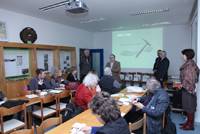 Typhoons or hurricanes affect large areas of the World, which are often densely populated (eastern cost of USA or eastern Asia). New evidence about dramatic increase in occurrence of strong typhoons since the end of 19th century exists just for eastern Asia. These new findings brought study published in Global Change Biology. The changing trend of extremely strong typhoons from 1880 was confirmed by the mean of analysis more than 30,000 tree-rings and climatic data about typhoon frequency and intensity. “Meteorological measurements of typhoon occurrence and intensity are usually limited for short period in Eastern Asia. Such kind of information does not allow reconstruction of longterm changes. However, combination of climatic records with tree-ring data allowed us to find relationship between typhoons and tree-growth and reconstruct the typhoon intensity much more farer to the history,” says first author of study Jan Altman of Botanical institute, The Academy of Sciences of the CR.
Typhoons or hurricanes affect large areas of the World, which are often densely populated (eastern cost of USA or eastern Asia). New evidence about dramatic increase in occurrence of strong typhoons since the end of 19th century exists just for eastern Asia. These new findings brought study published in Global Change Biology. The changing trend of extremely strong typhoons from 1880 was confirmed by the mean of analysis more than 30,000 tree-rings and climatic data about typhoon frequency and intensity. “Meteorological measurements of typhoon occurrence and intensity are usually limited for short period in Eastern Asia. Such kind of information does not allow reconstruction of longterm changes. However, combination of climatic records with tree-ring data allowed us to find relationship between typhoons and tree-growth and reconstruct the typhoon intensity much more farer to the history,” says first author of study Jan Altman of Botanical institute, The Academy of Sciences of the CR.
Scientist so concluded, that in searching period (from 1770) is evident change in typhoon
intensity. For the first part of searching period (1770–1879) was typhoon intensity equal, while
for the period from 1880 until now the trend of increasing typhoon intensity was recorded. “
Although tree-ring and climatic data were collected on Korean peninsula, we can apply these results
on whole East Asia where climatic models predict ongoing increase of tropical cyclones. If these
forecasts come true, changes of long-term processes in the landscape will occur. These changes will
also affect densely populated area as Korea, Japan, Taiwan or China,” added Jan Altman.
More information:
http://onlinelibrary.wiley.com/doi/10.1111/gcb.12067/abstract
Contact
Jan Altman, Botanical institute, The Academy of Sciences of the CR, Třeboň, Czech Republic
E-mail: altman.jan@gmail.com, Phone: +420736444844
Altman J., Doležal J., Černý T. & Song J.S. (2013) Forest response to increasing typhoon
activity on the Korean peninsula: evidence from oak tree-rings. Global Change Biology 19: 498–5
04.
22 Apr 2013


 Česky
Česky












